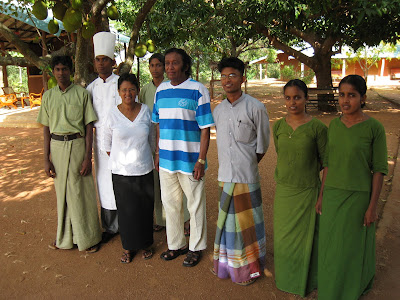
With Sharmaline
I joined St. Mary's College in 1966 hoping to do the Advanced Level examination as a biological science major in the English medium. Chilaw was within traveling distance from the coconut plantation where my dad worked, so I wouldn't have to be boarded as in Kandy. Also, my dad was experiencing another financial crisis and St. Mary's, being a government school, was a lot more affordable than the private Trinity College.
Soon after entering St. Mary's, my plans to study in the English medium were changed by the government, which decreed that all A/L classes should either be in Sinhala or Tamil medium. This caused much consternation to both the students and the teachers who did not have the fluency to study or teach science in Sinhala. We lacked textbooks (they were still being translated or were being written) and the Sinhala language lacked a scientific lexicon. So, for the four subjects I studied--Botany, Zoology, Chemistry, and Physics--I had to first purchase glossaries published by the government and learn awkward scientific words that had been created. Our teachers, mainly graduates of Indian universities, were not proficient at teaching in Sinhala. I especially remember Mr. Neville and Mr. Sanath, teachers of Zoology and Botany respectively, who were graduates of Madras universities. They were more fluent in English than in Sinhala. So, for a while, confusion ensued. However, despite these initial challenges, we managed to take a A/L exam in the Sinhala medium, and Sharmaline and I did reasonably well. Those days of dissecting rats and sharks in the zoology lab and Alan, the lab assistant,are fresh in my mind.
Two classmates I remember from those early days in 1966 are Sharmaline Perera and Bertie Dole. St. Mary's was a boys' school and Sharmaline was one of the two girls to attend because no A/L classes were available at the local girls school. In fact, she was the first female classmate I ever had. She was also the daughter of a teacher at St. Mary's and knew many staff members well.
Sharmaline later became a teacher of science, retired early, and now teaches at a private school in Colombo. Her children, two daughters, are both in Australia now. I met Sharmaline briefly after nearly 30 years at her home in Moratuwa.
Bertie Dole joined St. Mary's from St. Servatius College, Matara, in the deep south. His father was a excise inspector who was transferred from place to place, and Bertie came to Chilaw with his brothers. He was an excellent cricketer and captained two schools, St. Servatius and St. Mary's. He was also the Head Prefect at St. Mary's and was popular among both students and teachers. I only met Bertie once after leaving St. Mary's. He became a teacher of mathematics and died untimely from a heart attack.

With Jinasena
My closest friend at St. Mary's was Jinasena, who joined us when the medium of instruction became Sinhala. Jiansena came from a business family in Mahawewa, a few miles south of Chilaw. They owned the famous Leela Hotel and Stores. Because he was boarded at a house in proximity to St. Mary's, he had all the time for sports and extra curricular activities. We kept in touch even after leaving school. He would write me long letters in Sinhala when I was in the States, keeping me informed about St. Mary's and our old classmates.
Jinasena started a tyre business at Wennappuwa, close to my village of Boralessa. On my visits to Sri Lanka from the States and later from Hong Kong, I would visit him at the shop and his home. The business did not succeed and Jinanasena now calls himself a "retired businessman"! (He's only 58.) He has two sons. Interestingly, one has taken to Latin dancing!

Sunil with my dad
Sunil Costa was another classmate, still working for the Urban Council in the area where my dad resides. His wife Susila used to work for us when we owned a pharmacy in Chilaw, way back in the late 1970s and early 80's.
I also spoke on the phone with Dayananda Peiris. Dayananda joined us at St. Mary's somewhat later. He was from Bingiriya, a village some distance from Chilaw. To our surprise, he later joined the army and has risen in rank of colonel. He has one child, a daughter, who is an English instructor at a university.
Another classmate who comes to mind is Sarath Abeysinghe, who was the class musician. I haven't seen Sarath since the late 1970s. He now works as a tourist guide, I am told.
We plan to get together when I next visit Sri Lanka.

















































